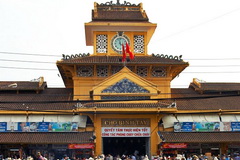Call us (84) 43 974 6373
Email info@jeweltours.com
Tra Su Cajuput Forest
Prior to 1975, Tra Su was destroyed by the enemy's bombs and became uncultivated area. After the war, authorities in An Giang Province invested to reforest cajuput and build a 12km long, 4m wide and 4m high dyke system that helps prevent the area from being swamped during flood season. The forest has been designated as a special restoration zone since 1983, with the target of becoming a renowned scientific forest and nature reserve.
The forest includes a 845ha special-purpose forest surrounded by a 645ha buffer zone. It is the habitat for many colonies of water birds, bats and various others such as rare and endangered animals and reptile species. Scientists estimate that it is home to over 70 species of birds, including 2 very rare species of Giang sen (Mycteria leucocephala) and the Dieng Dieng (Anhinga Melanogaster); 11 species of animals belonging to 6 families and 4 orders; 20 species of reptiles; 5 species of amphibians; 23 species of fish, including Ca com (Chitala ornata) and Tre trang (Clarias batrachus) having the scientific value and being in danger of extinction. The flora is equally abundant and splendid with over 140 specified floral varieties which represent the second largest number of plant species in the Mekong Delta region, only after the Xeo Quit Cajuput Forest in Dong Thap Province. They include 22 varieties of trees, 25 varieties of shrubs, 10 varieties of vines, 70 varieties of grasses, 13 species of aquatic plants, 22 varieties of ornamental plants, 9 varieties of fruit trees and particularly many varieties of medicinal herbs of high value.
The forest is sub-divided into several sites to make getting around easier, that include a 3,000m2 fishing area, a 3,200m2 bird sanctuary and a 2,500m2 bat sanctuary, all of which cater to the specific individual demands of different types of tourists.
If visiting the key sites by foot, the tourists must spend pretty much the whole day in the forest. However, if they jump in a motor-boat, it will save a lot of time, and permit a leisurely five hour round trip of all the significant sites throughout the ecological forest. They can view the lovely landscape as the scenery drifts along both river banks, enjoy the fresh air as well as listen to the magical music as performed by the birds of the forest and other jungle insects and animals. Apart from the birds and animals, the tourists will see the wonderful countryside and farmers busily attending to their paddies, orchards and so on, but still happy to stop for a chat with guests.
The best time to visit Tra Su is at the high water season, from September to November. At this time of the year, the entire forest floats on a vast area, so a motor-boat is the only way to travel around. Indeed, rowing along the green mysterious canals is a particularly good idea, since the tourists are able to stop as they chose to pick wild berries or fruits or go for a bit of fishing in quiet contemplation.
Apart from the significance of preservation and economic value, the area also boasts many unique cultural features as it is the home of the Kh'mer and Kinh people who practice several traditional handicrafts, such as brocade weaving, silk weaving, cooking Thot not (Borassus flabellifer) sugar, distilling cajuput essential oil, raising bees for honey, etc.
Endowed with peace and tranquility, Tra Su Cajuput Forest became a unique and attractive ecological destination for the tourists who love the beauty of the nature.
RELATED POST
-
.jpg)
Da Lat Palace Golf Club
The Da Lat Palace Golf Club is a golf retreat that soothes the senses, invigorates the body and calms the mind. Since the opening of Da Lat Palace Golf Club in 1922, it has hosted golfers from around the world.In early 1994, Da Lat emerged once again as the ideal golf retreat in Southeast Asia...
-

Tuyen Linh Temple
Tuyen Linh Temple was built from bamboo in 1861 near the Tan Huong channel in Minh Duc, Mo Cay, Ben Tre. The temple was firstly named Tien Linh, and led by Abbot Khanh Phong. In 1907, a monk name Le Khanh Hoa, an expert in Buddhism, was appointed to lead the temple and then in...
-

Cho Lon (Big Market)
In 1788, a group of Chinese from Pho and My Tho Islands came to Ben Nghe River Dike and founded a market which developed into the existent Cholon Market, offering a wide array of products. This is Vietnam's Chinatown market. It is an attractive site for visitors to observe that lively...
Your Prefer Place

Travel Styles in Vietnam
Our Destinations
Show all destinations in VietnamNewsletter register
Be the first to know about our exclusive travel offers and tour updates.







.png)